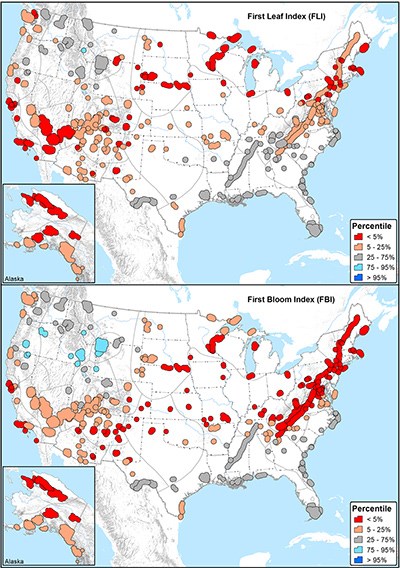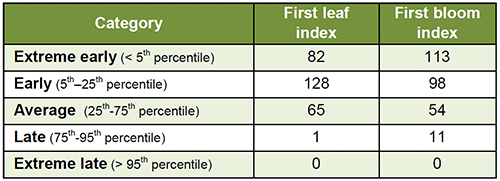Climate Change is Advancing Spring Onset across U.S. National Parks


Click image for a larger view
Background
Parks across the U.S. National Park System are already experiencing climate change. Changes in phenology – the timing of seasonal biological events (e.g., leaf-out, flowering, migration, and reproduction) – constitute one of the most immediate and easily observed responses to climate change. Changes in phenology are important to park managers because the timing of many activities depends on when these biological events occur. Management activities that need to be carefully timed include treating invasive species, operating visitor facilities, and scheduling seasonal events like flower and animal viewing. Studies have shown that most parks have already experienced warming that exceeds that experienced during the 20th century, but we don’t know how this may have affected the timing of flowering and other phenological events.
To evaluate changes in phenology, NPS evaluated the timing of spring onset (past 10-30 years) in 276 US natural resource parks relative to their historical ranges of variability (1901 – 2012). The study was a collaborative effort with the USGS, USA National Phenology Network, Cornell University, University of Arizona, Schoodic Institute, and the University of Wisconsin-Milwaukee.
Spring has already advanced in three-quarters of the 276 parks examined, and half of the parks are experiencing an "extreme" early spring that exceeds 95% of historical conditions as measured by first leaf index and/or first bloom index from indicator plant species. No parks are experiencing extreme delays in spring onset. Managers in the "extreme" early parks have thus already been working under relatively anomalous conditions for the past 10-30 years.

These findings show that already-documented changes in climate are causing significant changes in the seasonality of park organisms, and they illustrate how spatial variability in effects of climate change necessitates localized adaptation approaches.
Generally, areas that experience extreme early springs are likely more susceptible to ecological mismatches and species invasions. Invasive species tend to have more "flexible" phenologies than their native counterparts, enabling invasive species to better track earlier and more variable springs. This and other changes, such as the timing of the fire season and phenological responses of rare species, will help determine when monitoring of natural resources should occur, which may require parks to plan for earlier events, and employ more flexible management schedules. For example, parks may need to hire seasonal staff earlier in the year to coincide with increasingly earlier growth of invasive species.
Advances in the timing of spring will also impact visitor services. Parks see high levels of visitation in periods of warm (but not hot) weather and visitation across the park system is projected to increase with climate change. Given the relationship between visitation and air temperature, advancing springs also likely mean longer visitation seasons, with many implications for operations. Changes may be particularly notable at parks where spring events are key attractions (e.g., wildflower blooms).
Parks with high variability in the arrival of spring in recent years may need to plan a longer window around cultural events. For example, the Cherry Blossom festival in Washington, DC has evolved from a single day to a multi-week celebration in order to capture variation in spring onset as measured by peak bloom of cherry trees.
The coming decades are likely to see continuing changes in climate and phenology. Parks will need to adapt to both the challenges and opportunities posed by these changes.
Last updated: February 5, 2024
